Darbuka Basic Lesson
Watch the beginning chapter from instructional DVD “Worldpercussion 2 – Riq and Darbuka”
This is the typical goblet-shaped drum used in middle eastern music. There are different versions, like the egyptian version with a round rim and the turkish one, on which some different techniques are used. Most Darbukas nowadays are mostly made from metal with a synthetic head, but as the modern fingerstyle of playing gets more popular, clay instruments with natural skin are used more frequently again. In midle eastern percussion ensembles the darbuka player usually plays the solo parts.
Position
The darbuka or doumbek or egyptian tabla is probably the most popular drum from the middle east. It is placed on the left leg (for right-handed) and the left arm rests on the body of the instrument.

Doum
To produce the bass sound, you hit the drum with your flat right hand and let it bounce off immediately. The fingers are together and straight.

Pa
For the slap sound on the darbuka, the finger must be more loose than for the bass and you keep them on the skin. It is similar to a slap on a conga. This stroke is not easy in the beginning, it takes some time to get the right sound.
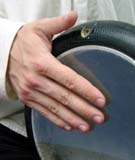
Tak
For the rimstoke with the right hand you put together middle- and ring finger and hit the very edge of the skin. On the left hand use the same fingers. Here it is a little bit more tricky. With a wrist movement you “throw” them down onto to the rim. It seems to be impossible in the beginning, but if you give it some time it will come.
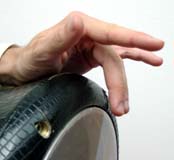
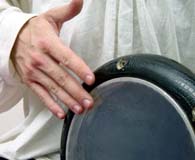
The left-hand double stroke
This stroke is used to do ornamentations and make the rhythm a little more “spicy”. First hit the skin with the left ring-finger followed by the left index finger. The sound should be muffled. Again, most of the energy comes from the wrist which does a sidewards movement.
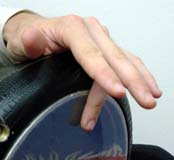
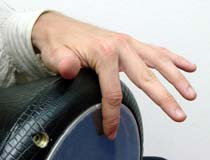
Darbuka-notations
This first rhythm is a middle eastern dance rhythm in 2/4 called Ayoub. For the first example use the right hand for the bass and the left hand for the taks.

![]()
It is also nice to substitute the last tak with a slap. In this case we have to change the fingering to play the slap with the right hand:

![]()

![]()
It is nice to combine the patterns from above:

![]()

![]()
The next rhythm is a very famous dance rhythm called Maqsoum. It is used a lot to accompany belly-dancers. Below is a very basic version. Just the basic rhythm without any ornaments or fill-notes:

![]()
This one is called “walking” Maqsoum:

![]()
Now add the left hand double stroke before the taks:

![]()
The rhythm called “belledi” is very similar. Just play a second bass instead of the first slap:

![]()







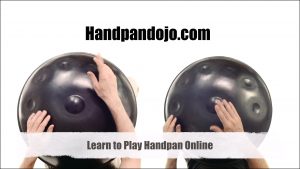
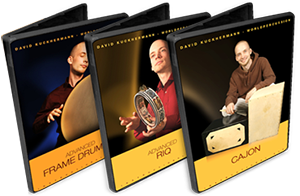
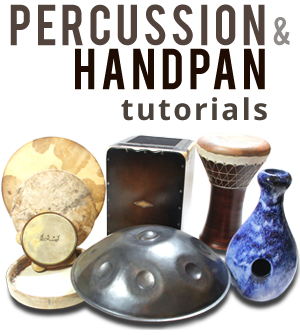
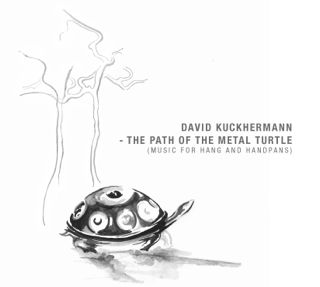
thanks david for your tutorial,found it really good and easy to learn the basic strokes although different from my djembe strokes, now I can play basic on the darbuka, thanks again david.
graham
hi david i am new but i have my son he has a drum darbuka but he wants to learn how much is the cost
I´m armenian descendant and I recently bought an egyptian darbuke, for learning how to play it. Thanks to you I know few helpfull lessons. Greetings from Argentina
Hallo David,
when I was in marrakesh I bought a darbouka. Now I am starting to learn with your tutorials. Thank´s a lot and go on like this!
Best regards from Kleve
Felix
ps: I am looking forward to having a personal training-session with you 😉
THAAAANKS!!! i have 1000 questions!
great work…but if there be more sheet it’d be super……)
I’m just learning how to play the darbuka and this helps a lot – especially the sound examples for the various rhythms are great.
Thanks a lot!
Pingback: Tears of Joy field trip | Ms. Isberg's Class
Hey David!
I’m a Turkish singer&song writer who lives in Amsterdam for five years. After trying different instruments for so many years, I’ve discovered the love of rhythm in me and through searching I found u. I appreciate ur work and the way u present it.
thanks a lot!
HW